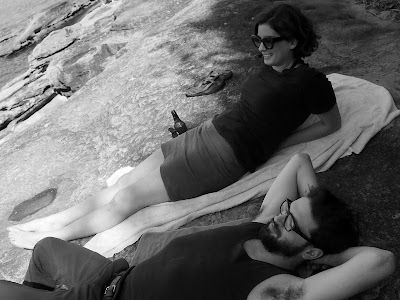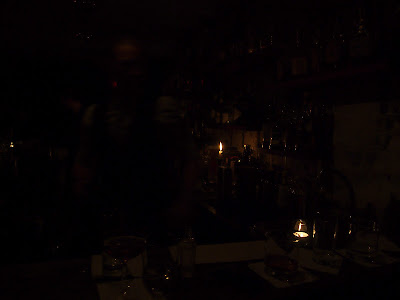It is an all too uncommon to feel the genuine, visceral effect of a work of art. A recent return to Canberra gave me an opportunity to look back on a time where a painting struck me with such obvious and enduring force, as to jolt me out of a rapidly darkening personal malaise.
From the first experience, time spent in front of Blue Poles, became moments of both escape and drew attention to a rapidly darkening spark life.
It should surprise none to know that I am no art critic, nor even a student of its history or technique. And even were I to be able to claim such a background, I would not seek to focus upon the technical merit of Pollocks work, nor what it represents in the development of abstract expressionism. For while the effect of the painting itself has lead me to try to understand these things, it was not technical merit nor Pollocks status, that made this work so impressive and important to me at the time.
Indeed it is possible that, at the time of my first impressions, when time in front of it assumed a meditative, almost revelatory quality, I am not sure that I could consciously articulate what it was that drew my gaze and my mind into the mesmeric tangle of drips and splatters.
It is only later, in the clear minded moments of reflection, years in the future, that I can look back at myself then, and at the painting itself, and wonder not just at its genius, but at the powerfull connection it was able to make with a fragile, lost mind like my own had been.
...
Pollock is once, famously, to have responded that he 'was nature', when asked if he painted from nature. In Looking back into my discovery of Blue Poles, and how it affected me, I have some understanding of what he was asserting. At the least, I have some impression that a sense of 'nature' and its energy, complexity and vitality, is what I felt in it.
For those not familiar with it, I feel woefully unqualified to give a sufficient impression through description. An enormous canvass. It seems a cut-out snapshot from something greater, even infinite. An intense overlaid structure of knotted drops, spatters, spandrels and webs of coloured paint. A seething surface of aesthetic vitality, energy and movement captured and expressed with a precise, fluid use of colour and texture that draws the eye from across the room, and drags it deeper into the perpetually receding tangle.
If the canvass is as a cut-out from an infinite whole, then the painting itself becomes a snapped instant in time and space. As though one stood at the edge of the universe, looking back through its infinite stretch of space and time, into the moments of origin. In those strands and interwoven tangles of paint, one gets a momentary glimpse of the interconnected universe. The unimaginable super-massive scale of galaxies, infinitely receding back through oneself, into the sub-atomic and beyond.
At once, one could be cast out in the middle of a galaxy of exploding and reforming stars, or amidst the infinitesimal spatter of bossons in a super-colider. And in that beautiful duality, is comfort.
Perhaps it is in that seeming depiction of the perfect moment of infinity, the energy, vitality and connectivity of life, that I found my place. Grounded in the scale of the universe and my part in it.
In the way that one gazes at the stars, or looks down at our little blue planet, and feels the squirming swamp of the trivial evaporate, perhaps it was the glimpse of an energised, connected infinity that so resonated with me, and gave me comfort.
At once, one could be cast out in the middle of a galaxy of exploding and reforming stars, or amidst the infinitesimal spatter of bossons in a super-colider. And in that beautiful duality, is comfort.
Perhaps it is in that seeming depiction of the perfect moment of infinity, the energy, vitality and connectivity of life, that I found my place. Grounded in the scale of the universe and my part in it.
In the way that one gazes at the stars, or looks down at our little blue planet, and feels the squirming swamp of the trivial evaporate, perhaps it was the glimpse of an energised, connected infinity that so resonated with me, and gave me comfort.
In the years since its creation Blue Poles has been analysed for its fractal qualities and there has been speculation and conjecture as to how relevant or important this is. Pollock himself is both lauded as one of the Titans of modern art, and denigrated as a symbol of the over-estimation of modern artists driven by a market looking for fodder. For myself, as I sat in front of it again some 9 years later, I considered Pollocks claim to be nature, and even the fundamental project of abstract expressionism and the pursuit of the subconscious, and came to no conclusion, but one.
The painting still has a magnetic sense of the infinite.
Years later, after countless hours spent in front of it, I still find in it an anchoring harmony as it draws my gaze deeper and deeper into that seeming infinite.




















































